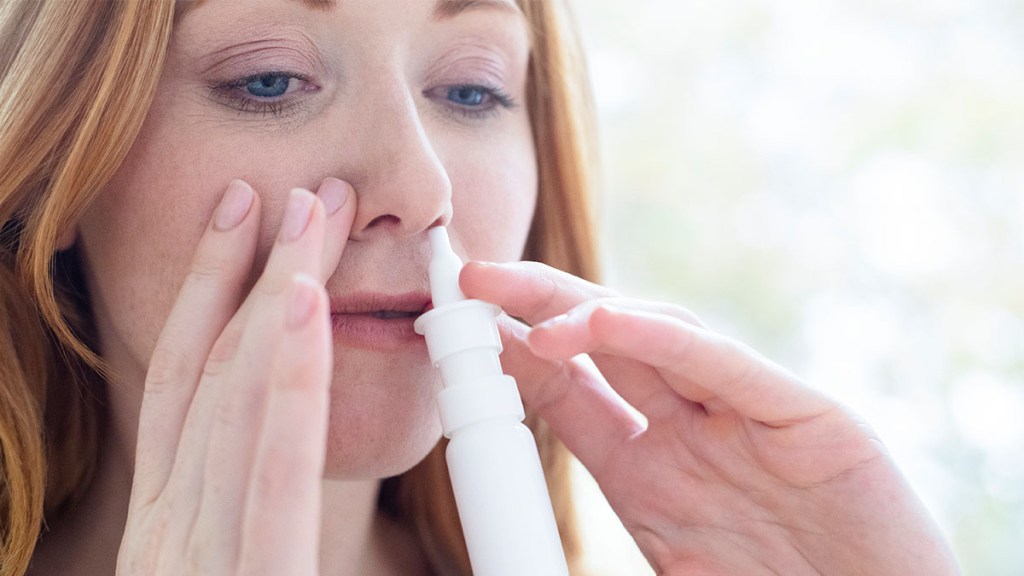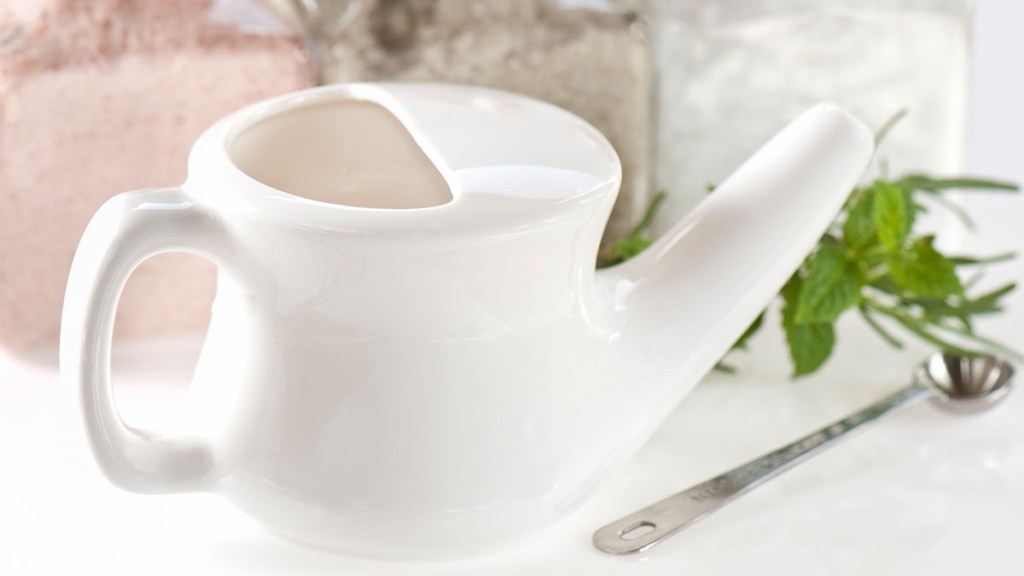The Best Nasal Decongestant Spray To Use Now That The FDA Has Found Decongestant Pills Don’t Work Isn’t A Spray At All
We tapped otolaryngologists from Stanford and Johns Hopkins to sort it out for us — their fix is cheap & easy

When you’re sniffling, sneezing and stuffed up, it makes sense to reach for a decongestant to feel relief from the pressure and to simply be able to breath again. But a Food and Drug Administration (FDA) review committee just concluded that phenylephrine, a key ingredient in over-the-counter decongestant pills, doesn’t actually work when taken as an oral pill because less than 1% of it make it from your gut to your nose. The committee also noted that phenylephrine does work when it’s in the form of nasal decongestant spray. The convoluted messages are enough to make your head hurt even if you aren’t congested! Indeed, millions of stuffed-up people are now wondering, what is the best nasal decongestant spray? So we talked to doctors from Stanford and Johns Hopkins to get the answer.
What the FDA committee says about decongestant pills
An FDA panel met and decided that the current data doesn’t support the recommendation of oral phenylephrine as a nasal decongestant. Now we wait for the FDA as a whole to take action. If they agree, some single-ingredient tablets, liquids and dissolvable strips, such as Sudafed PE or Contac-D, may come off the market.
That doesn’t necessarily mean the cold medicines in your medicine cabinet are ineffective. The FDA committee concluded that just because phenylephrine doesn’t work doesn’t mean the other ingredients in a multi-ingredient cold formulation don’t work. That means oral products with multiple active ingredients, like Alka-Seltzer Plus Cold and Cough Formula (which contains aspirin, chlorpheniramine, dextromethorphan and phenylephrine) or Advil Cold and Flu (with ibuprofen, phenylephrine and chlorpheniramine), can still work for other symptoms, such as muscle pain, headache or cough. (Click through to our sister site to find the best throat lozenge for coughs.)
Why phenylephrine became so popular
Phenylephrine became a common ingredient in cold medicines about 20 years ago. That’s when medicine makers starting using phenylephrine instead of another decongestant called pseudoephedrine. Because pseudoephedrine can be used to make the highly addictive stimulant methamphetamine (meth), in 2006 the government limited the sale of products that contained it. In order to buy a product containing pseudoephedrine, you now have to show photo identification to the pharmacy clerk or online robot to check out and pay.
What the FDA committee says about nasal sprays
Here’s where it gets confusing: In a twist, nasal sprays that deliver phenylephrine (such as Neo-Synephrine Nasal or Sinex Nasal) are considered effective. The FDA says, “the advisory committee’s discussion and recommendations are only related to orally administered phenylephrine, and not the nasal spray form.” That’s because nasal decongestants are more efficient at delivering the phenylephrine than oral ones because you’re spritzing the drug directly onto the tissues where it needs to act. Trouble is, although these sprays my technically work, doctors recommend against their use because they’re addictive.
The problem with many OTC nasal decongestant sprays

You can buy nasal decongestant sprays containing phenylephrine, like Neo-Synephrine and Rhinall, as well as sprays with another ingredient, oxymetazoline (found in Afrin, Dristan, and Mucinex Nasal Spray) over the counter.
Both phenylephrine and oxymetazoline constrict the small vessels inside your nose, explains Zara Patel, MD, professor of otolaryngology at Stanford University Medical School. “Because the lining of your nose has a high number of these blood vessels, by constricting this blood flow, you can shrink down the tissue, thus opening the nasal airway and allowing more air to flow through the nose,” she says.
But these products aren’t ideal. Keith Sale, MD, an otolaryngologist with the University of Kansas Health System, says these drugs should not be used for more than 3 to 5 days because they can cause a “rebound effect” that actually makes congestion worse after stopping the medication.
Dr. Patel concurs. “I tell patients to avoid these sprays if at all possible because they are highly addictive and bad for the nose if used more than three days at a time,” she says.
The rebound effect “can lead to a desire to continue use to keep the nose open and is why some refer to the medication as addictive,” warns Dr. Sale. “Overuse can lead to a vicious cycle of escalating need for more of the medication to keep the nasal passages open.” Dr. Patel adds, “Long-term, the effect is even worse, causing significant dryness and pain inside the nose, leading to a process called atrophic rhinitis, which we currently have no cure for.”
Why experts caution against over-reliance on any kind of decongestant
For these and other reasons, many experts discourage the use of decongestant medications without medical supervision. In general, decongestant medicines are frowned upon, notes Jean Kim, MD, PhD, associate professor of Otolaryngology-Head and Neck Surgery at John Hopkins University School of Medicine. She stresses the importance of seeking a diagnosis from your doctor, since congestion can be caused by many different things. Indeed, anything that irritates the inside of the nose, including colds, allergies, tobacco smoke or pollution, can cause a stuffy nose. “Many, many medical conditions can result in symptoms of nasal congestion, including non-nasal problems,” says Dr. Kim. For example, she says, migraine can be perceived as nasal congestion. Congestion can even be a side effect from medication.
The best nasal decongestant sprays
The good news? Natural nasal decongestant sprays can help you breathe until you can see a doctor, or just so you can sleep through the night. Read on for the most popular options — and the ones MDs recommend most. (Click through for more natural cold remedies.)
#1 nasal decongestant spray: Saline nose sprays
Dr. Patel and Dr. Sale agree that saline nose sprays like Simply Saline (buy on Amazon, $8.19 for 4.5 oz), Ayr Saline Nasal Mist (buy on Amazon, $11.99 for two bottles), are very helpful. “Salt water sprays are a great moisturizer and can help thin out nasal mucus to improve flow,” says Dr. Sale.
To boost the benefits, opt for a rinse infused with Dead Sea salt. Research in the journal Operative Techniques in Otolaryngology found that Dead Sea salt improves symptoms, thanks in part to its rich stores of magnesium, which has been shown to decrease symptom-causing inflammation. One to try: Nasova Saline Spray with Natural Dead Sea Salt (Buy on Amazon, $9.95 for 4.2 oz).
#2 nasal decongestant spray: Essential oil sprays
A small study published in February 2023 in the Journal of Allergy and Clinical Immunology suggests that an essential oil nasal spray with a combination of essential oils may be helpful with seasonal allergic rhinitis. In the study, people who used a blend of menthol, eucalyptol, thymol, camphor, birch oil, pine oil, cinnamon and mint essential oils experienced a 40% reduction in symptoms like runny nose, cough and postnasal discharge. The blend can be found in the product Sinusol (buy on Amazon, $28.99 for a 2-oz bottle). “Larger studies are needed to prove efficacy, but these sprays may be a promising alternative,” says Dr. Sale.
Prefer taking a bath to spritzing a spray? Animal research in the journal Frontiers of Pharmacology suggests that adding 10 drops of eucalyptus essential oil to a bath can boost your immunity and help cut your recovery time in half if you do get sick. Steamy soaks drain sinuses and reduce airway inflammation, says study co-author Bill White, PhD, while the oil’s aromatic compounds stimulate your immune system to produce virus-killing cells [CD8 T-cells]. (Click through to learn how essential oils can help with focus and weight loss.)
#3 nasal decongestant spray: Capsaicin nasal sprays
These sprays and mists, like Nasol Natural Nasal Sinus Spray (buy on Amazon, $39.95 for two bottles) and Sinus Buster Nasal Spray (buy at SilverSinus.com, $21.95) contain capsaicin, the substance that gives chili peppers their heat. Capsaicin stimulates the trigeminal nerve receptors in the nose, according to Dr. Patel, but “it does nothing to actually ‘open’ the airway, it just stimulates the same nerves that airflow stimulates, and thus you feel like you are breathing more freely.”
Still, whatever capsaicin spray does, many folks swear by it. And a study published in Annals of Allergy, Asthma and Immunology showed that intranasal capsaicin improves symptoms in those with nonallergic rhinitis (NAR), easing congestion in less than a minute. Another report, a systematic review of four studies, concluded that “capsaicin appears to have beneficial effects on overall nasal symptoms.” (Click through to see how capsaicin-rich hot honey can ease coughs, congestion and sore throats.)
The best non-spray nasal decongestants
If you’d rather not use a nasal decongestant spray, there are more options, and they can be much more effective than using a nasal spray, according to the doctors we spoke to.
#1: Nasal irrigation
Studies show that saline, or salt water, irrigation, reduces nasal congestion and reduces the need for medications in allergy sufferers. The only difference between nasal irrigation (also known as nasal lavage, nasal cleansing or saline rinsing) and saline sprays is the application method.
Dr. Patel highly recommends the practice, saying, “It is extremely safe and effective and well tolerated when used correctly, with the right type of water and the right head position.” Here, she herself demonstrates the technique:
Dr. Patel’s easy how-to:
- 1. Pour 1 packet Neilmed salt (Buy on Amazon, $12.99 for 100 packets) and 1 cup of water into a Neilmed irrigation bottle (Buy on Amazon, $8.49) up to the dotted line.
- 2. Irrigate each nostril with half the bottle of saline solution 2 times a day. While in the shower or over the sink, tilt your head forward to a comfortable level. Put the tip of the rinse bottle into your nostril, aiming it toward the top of your head. Gently squeeze the bottle to flush out your nose. The fluid will circulate in and out of your sinus cavities, coming back out your mouth or from the opposite side of your nose. Try not to swallow large quantities and spit it out instead.
- 3. Make sure you keep the bottle clean. Rinse out bottle and wash the tip with soap and water daily. Allow it to air dry.
Once a week, sterilize the bottle with a 1:1 solution of water and hydrogen peroxide or 1:1 of water and bleach. Shake solution and squirt through nozzle, making sure solution flows over nozzle tip. You can also was the bottle parts in the dishwasher 1 or 2 times per week.
For a similar nasal rinsing technique using things you already have at come, click through to what the American Academy of Allergy & Immunology recommends.

#2: Sinus steam tent, shower or inhaler

This technique is a variation on the same cleansing theme. Steam inhalation, or breathing in steam from heated water, helps loosen music and ease congestion symptoms. To do it, simply pour just-boiled water into a bowl. Keeping your skin about six inches from the water to avoid burns, place a towel over your head and inhale the steam for about 5 minutes.
While steam inhalers, devices that help steam inhalation, are not necessary, they may make the practice easier. Two to try: Vicks Personal Sinus Steam Inhaler (buy on Amazon, $39.90), which helps filter tap water for you, and Mabis Facial Steamer and Steam Inhaler (Buy on Amazon, $30), which may be eligible for FSA funds.
For more cold and flu news, keep reading:
MD: 5 Surprising Ways Alka Seltzer Can Help You Sail Through Sick Season
Study Proven: These Tricks Make Medications and Vaccines Work Faster and Better
This content is not a substitute for professional medical advice or diagnosis. Always consult your physician before pursuing any treatment plan.













